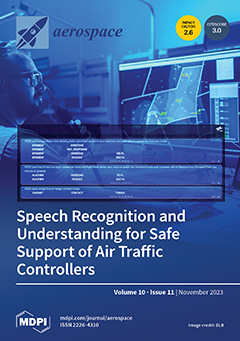Open AccessArticle
Modification of Space Debris Trajectories through Lasers: Dependence of Thermal and Impulse Coupling on Material and Surface Properties
by
Denise Keil, Stefan Scharring, Erik Klein, Raoul-Amadeus Lorbeer, Dennis Schumacher, Frederic Seiz, Kush Kumar Sharma, Michael Zwilich, Lukas Schnörer, Markus Roth, Mohamed Khalil Ben-Larbi, Carsten Wiedemann, Wolfgang Riede and Thomas Dekorsy
Viewed by 1399
Abstract
Environmental pollution exists not only within our atmosphere but also in space. Space debris is a critical problem of modern and future space infrastructure. Congested orbits raise the question of spacecraft disposal. Therefore, state-of-the-art satellites come with a deorbit system in cases of
[...] Read more.
Environmental pollution exists not only within our atmosphere but also in space. Space debris is a critical problem of modern and future space infrastructure. Congested orbits raise the question of spacecraft disposal. Therefore, state-of-the-art satellites come with a deorbit system in cases of low Earth orbit (LEO) and with thrusters for transferring into the graveyard orbit for geostationary and geosynchronous orbits. No practical solution is available for debris objects that stem from fragmentation events. The present study focuses on objects in LEO orbits with dimensions in the dangerous class of 1 to 10 cm. Our assumed method for the change of trajectories of space debris is laser ablation for collision avoidance or complete removal by ground-based laser systems. Thus, we executed an experimental feasibility study with focus on thermal and impulse coupling between laser and sample. Free-fall experiments with a 10 ns laser pulse at nominally 60 J and 1064 nm were conducted with GSI Darmstadt’s nhelix laser on various sample materials with different surfaces. Ablated mass, heating, and trajectory were recorded. Furthermore, we investigated the influence of the sample surface roughness on the laser-object interaction. We measured impulse coupling coefficients between 7 and 40 µNs/J and thermal coupling coefficients between 2% and 12.5% both depending on target fluence, surface roughness, and material. Ablated mass and changes in surface roughness were considered via simulation to discriminate their relevance for a multiple shot concept.
Full article
►▼
Show Figures





